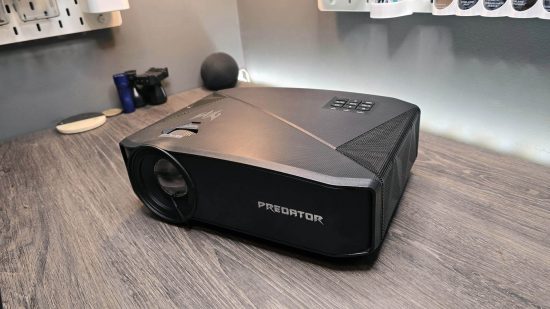Our Verdict
Acer’s Predator GD711 is a gaming-focused projector with a variable refresh rate. With 4K resolution and some super convenient image adjustment settings, it’s more like a monitor than a projector. Yet, its washed-out colorscape leaves a lot to be desired.
- Super easy configuration
- 4K resolution
- Expansive settings
- Colors need some tweaking
- Speakers are poor
- Limited availability
Acer’s Predator GD711 is the latest in the company’s long line of solid gaming projectors. Unlike some of its H and X series siblings (all of which are more designed for casual filmgoers) the Acer Predator, as its name suggests, is tuned around the gaming market. It treads a fine line incorporating features you’d typically find on a top-tier gaming monitor, with the best tech the projector market has to offer.
It might sound odd at first, (particularly given the high refresh rate OLED monitors and TVs that are available out there today), but the best gaming projectors can keep up and provide a top-tier gaming experience, across consoles and PC. It’s certainly something worth experiencing, particularly if you’re curious about the medium.
Of course, it’s not going to be quite as potent as those top-tier units, and there are very few products out there capable of hitting the heady frame rates and response times of some of the best gaming monitors without breaking into the four-figure price front, but if you’re a casual gamer playing a bit of everything, and have the space, and not performing at a competitive level, then a good gaming projector is the place to be.
Now I’ve been testing monitors, projectors, and panels from all walks of life for the last eight years or so, and have even worked behind the scenes providing feedback on particular units. So I can say without a doubt that Acer’s Predator GD711 is a confusing unit.
Why? Well simply put, it’s the price tag and availability of this thing that gives the most pause for thought. With limited availability in the US and a $1200-1400 price tag (£1,200 in the UK), it’s a big investment to put down for the spec. Let me explain why.
Why you can trust our advice ✔ At PCGamesN, our experts spend hours testing hardware and reviewing games and VPNs. We share honest, unbiased opinions to help you buy the best. Find out how we test.
Specs
| Max resolution | 3840 x 2160 |
| Max refresh rate | 240 Hz (PC), 120Hz (Console) |
| Contrast Ratio: | 2,000,000:1 |
| Colors | 1.07 Billion |
| Life expectancy | Up to 30,000 Hours |
| Response Rate | Not Listed |
| Connectivity | Wireless Dongle, Remote only, 2x HDMI 2.0, 1x USB 3.0 |
| Dimensions | 320 x 230 x 109 mm |
| Weight | 3.2 kg |
Design
The overall design of the GD711 is a fairly slimline affair, it’s certainly a far more appealing offering than something like Benq’s X3100i, with its boxy form factor and bulky weight. No, the GD711 comes in at just 32 x 23 x 10 cm, in a slender rectangular box that you’re probably used to seeing since the dawn of the projector to be quite honest.
And at just 3.2 KG it’s hardly a heavy unit either, so ceiling mounting it is an easy affair. Acer includes a full guide in the user manual on just how to do that, although it does require you to pick up an additional universal projector ceiling mount.
If you intend to use it just on a table, or a shelf the GD711 has adjustable feet to get the proper angle you need too. The throw range is pretty good as well. Popping the unit 2.2M back will net you a display equivalent to around 80 inches or so. Crank it back by 8.1 meters and theoretically you can throw up an image as large as 300 inches.
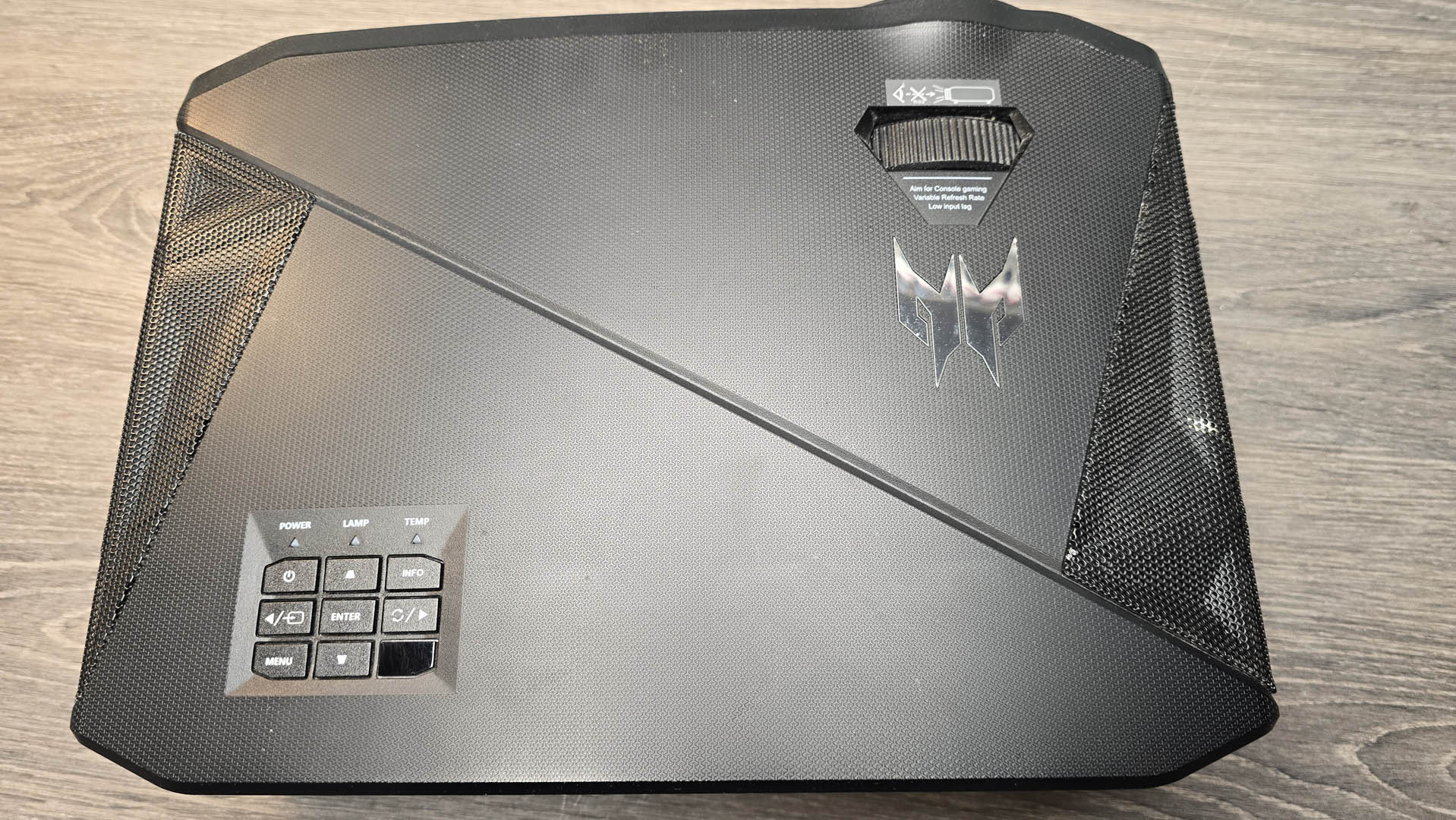
Cooling is handled by an internal fan setup, both the rear and one side of the unit (closest to the lens) house cool-air intakes, and the opposite side acts as an exhaust. It’s running a positive pressure system here to minimize dust build-up, but both intakes and exhaust are covered in mesh to help reduce that regardless.
There are built-in OSD menu buttons, allowing you to actively change source, re-sync the projector, and cycle through the numerous menus, located at the very top, along with a focus ring/dial just above the lens, and an attached lens cover as well to keep it safe during transportation.
For I/O you get two HDMI 2.0 ports, a USB A 2.0 port (for keyboard and mouse control) a USB A 5V DC service connector, analog audio out, and more interestingly a USB A Wireless Dongle. The GD711 also comes with its own remote control, providing the same selection of buttons as found on the projector itself as well.
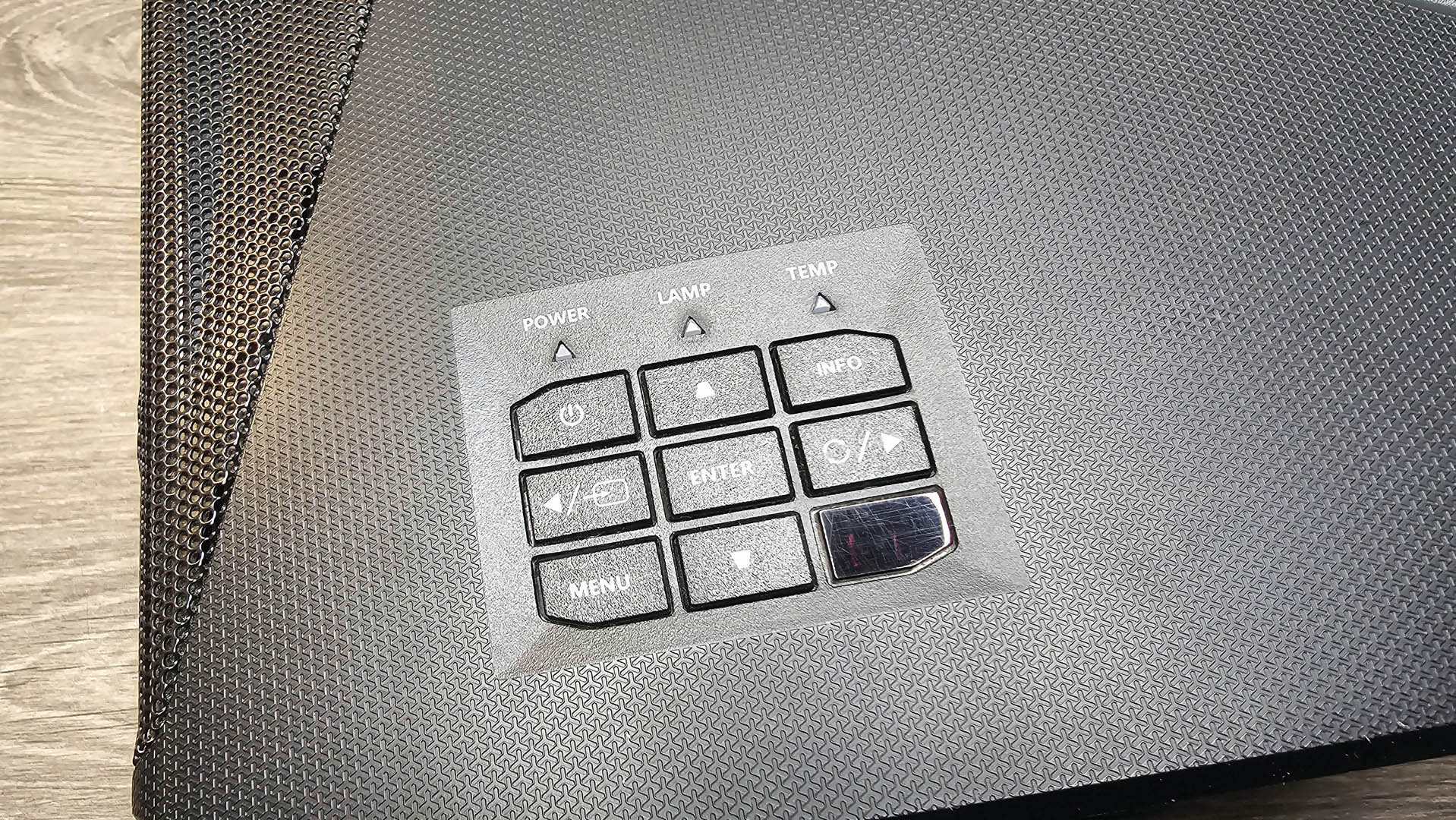
Features
On the surface, the GD711’s top-line stats read like a wish list for any gaming-enthused monitor junky. 3840×2160 4K resolution, huge contrast ratio (2,000,000:1) access to a massive 1.07 billion colors, 4000 Lumens max brightness, HDR10 support, 30,000 hours life expectancy, variable refresh rate tech, and a max 240 Hz refresh rate, (although that is fairly caveated that last one).
The real confusion surrounds latency. There are a lot of reviews out there suggesting the latency on this unit is incredibly good, but most of that seems to be referring to the refresh rates available instead. In terms of actual latency, It’s hard to know for sure, outside of subjective feel (we still don’t have fantastic testing methods for that just yet), as Acer hasn’t provided any details concerning what the response rate of the GD711 is.
It does however have a significantly wide array of refresh rates dependent on what resolution you’re gaming at. If you’re at 4K you are limited to just 60 Hz, (a natural limitation of HDMI 2.0 anyway), 1080p then you can tap out at 240 Hz (as long as it’s on PC), and for console 1080p 120 Hz is the max.
The real smart trick is how Acer is handling the keystone. It’s very impressive, in short, to avoid any form of twisted or trapezoidal distortion due to the projector itself being angled incorrectly, it’ll auto-adjust the lens to compensate if the device is not level, or tilted incorrectly, eliminating any skew issues whatsoever.
You of course get your typical manual 2D Keystone adjustments as well along the horizontal and vertical axis, but having this extra step automated is a seriously intelligent design choice.
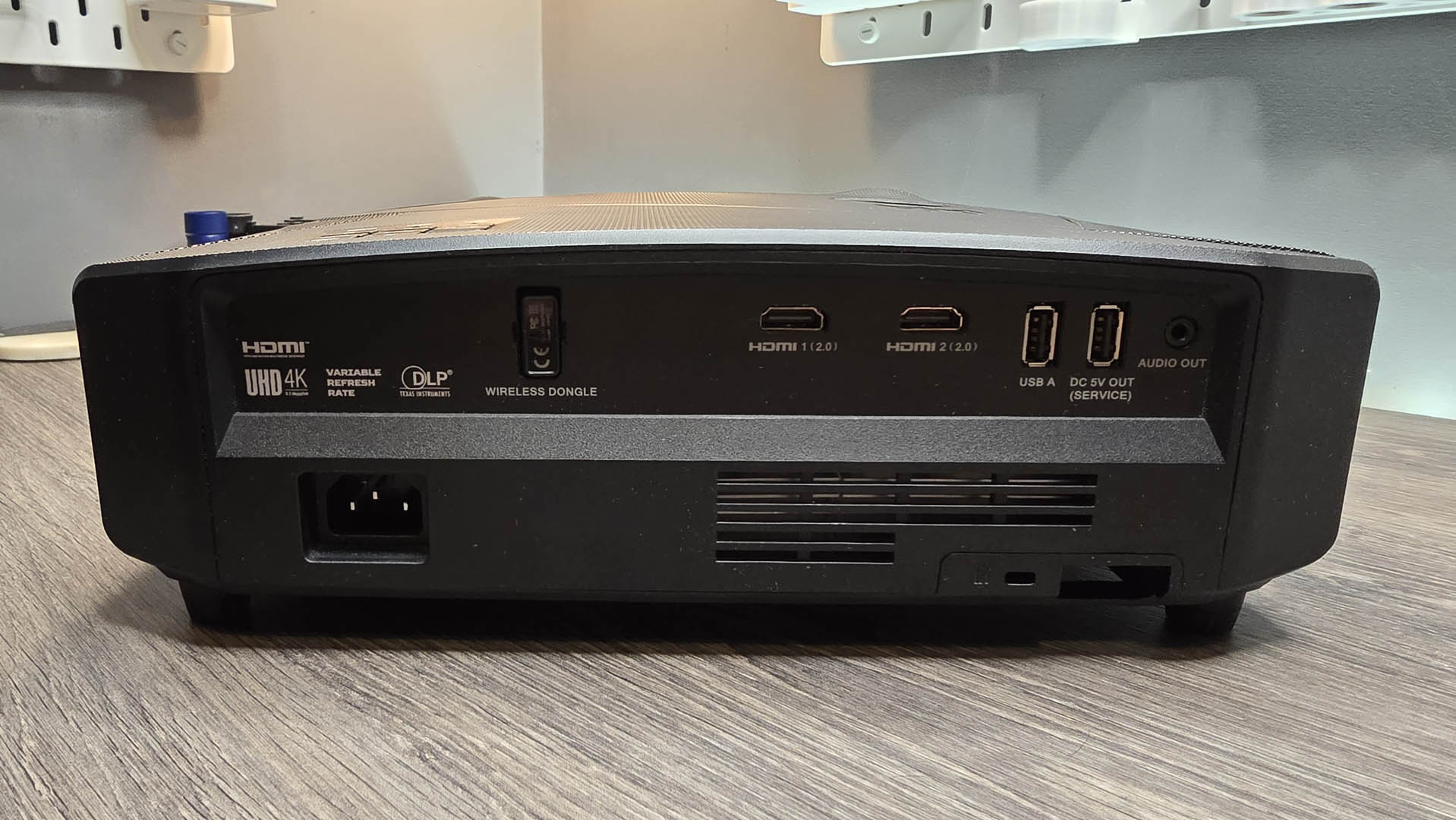
Performance
I spent a good few days testing the GD711 across several different media types from film and entertainment to gaming and YouTube. I’ve got to say it’s quite impressive, particularly at 4K 60 fps. The clarity of the image is superb. Although I am testing with a relatively short throw distance, creating a 50-inch screen, your mileage may vary at higher throw distances.
What’s less great was the color reproduction. No matter what I tried, overall color accuracy without HDR enabled in Windows or on the PS5 felt somewhat washed out compared to similar competitors at this price point and slightly higher. Don’t get me wrong, it’s not an awful experience by any means, but if you’re used to the crisp color clarity of something like a 55-inch OLED LG TV or even a modern IPS or VA monitor, the GD711 leaves a lot to be desired.
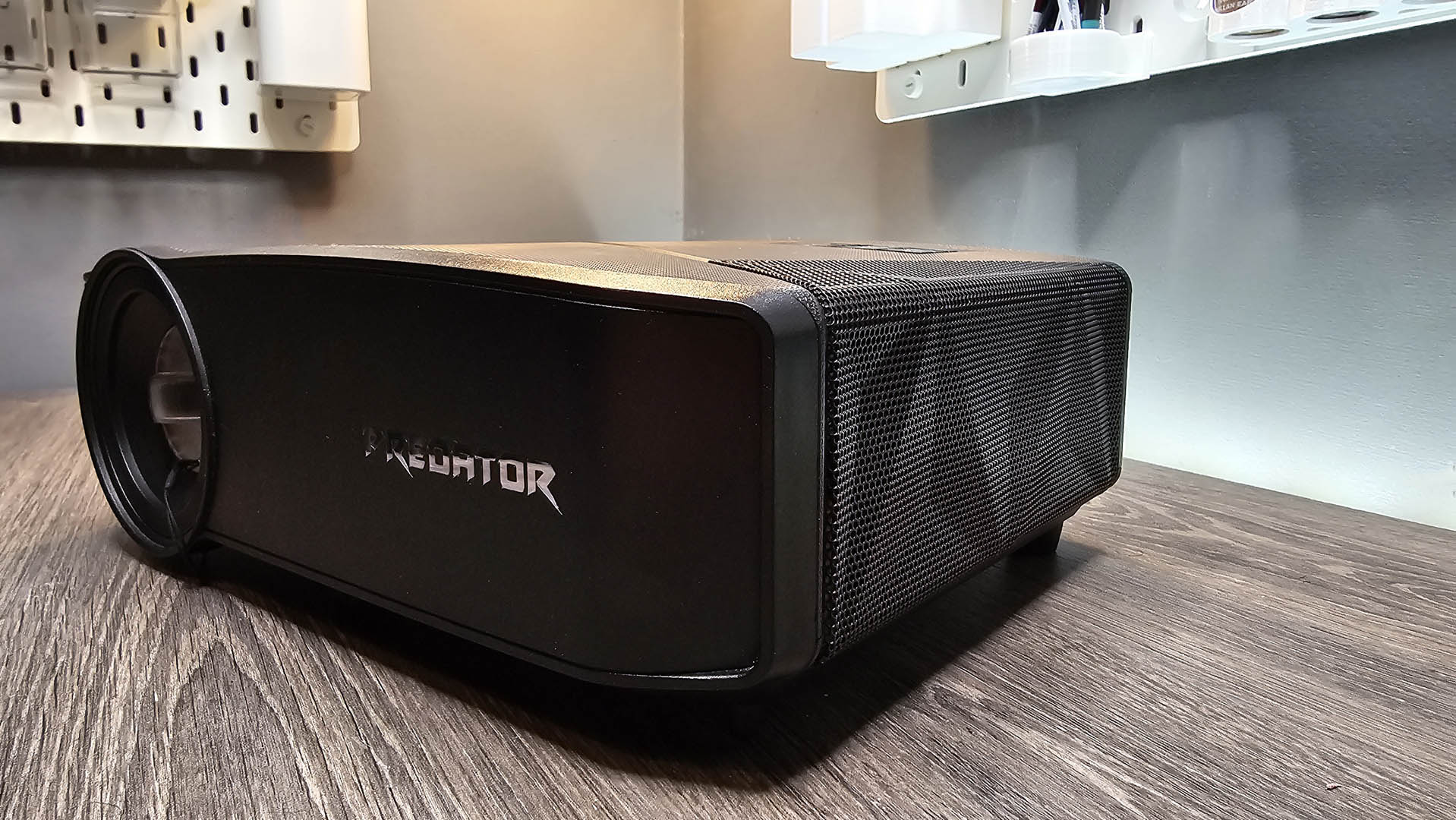
You can of course tweak the settings heavily, switching between mode types, and color-correcting every element to try and get to that perfect reproduction, but that can be incredibly challenging, and even my best dialed-in settings didn’t feel quite as competent as something like (admittedly much more expensive) BenQ’s X3100i.
Overall the responsiveness felt solid, however, and if there weren’t any major latency issues between me and my less-than-competitive RPG and RTS brain, it was hard to notice. Total War Warhammer III and Star Wars: Jedi Survivor were an absolute blast to play, and I saw no discernable difference in my death rate compared to on a full-size display.
The problem I have is the price. If you’re looking to game on this at 4K, you’re going to be using a PC. For half the cost you could pick up something like an AOC AGON Pro AG324UX, a full IPS, 144 Hz, 31.5-inch panel, with FreeSync Premium, 1ms G2G. If you want something a bit more sizeable, the best 4K gaming monitors include LG’s 48GQ900-B is a 48” 120 Hz 4K OLED display, for just over $1000, and Gigabyte will even sell you a 54.6-inch 4K VA display for just $700.
This puts the Acer Predator GD711 in a bit of a sticky position to be in. We knew that going into this of course, but you need to a) have the space to take advantage of its larger screen size, and b) be in that position, and also cash limited to the point of not being able to invest an extra $600-700 into something with a bit more punch. It’s still great for gaming, and as an entry-point gaming projector, the feature set is rich enough to keep any passionate gamer happy, but if you want a little more versatility, you might want to look elsewhere.
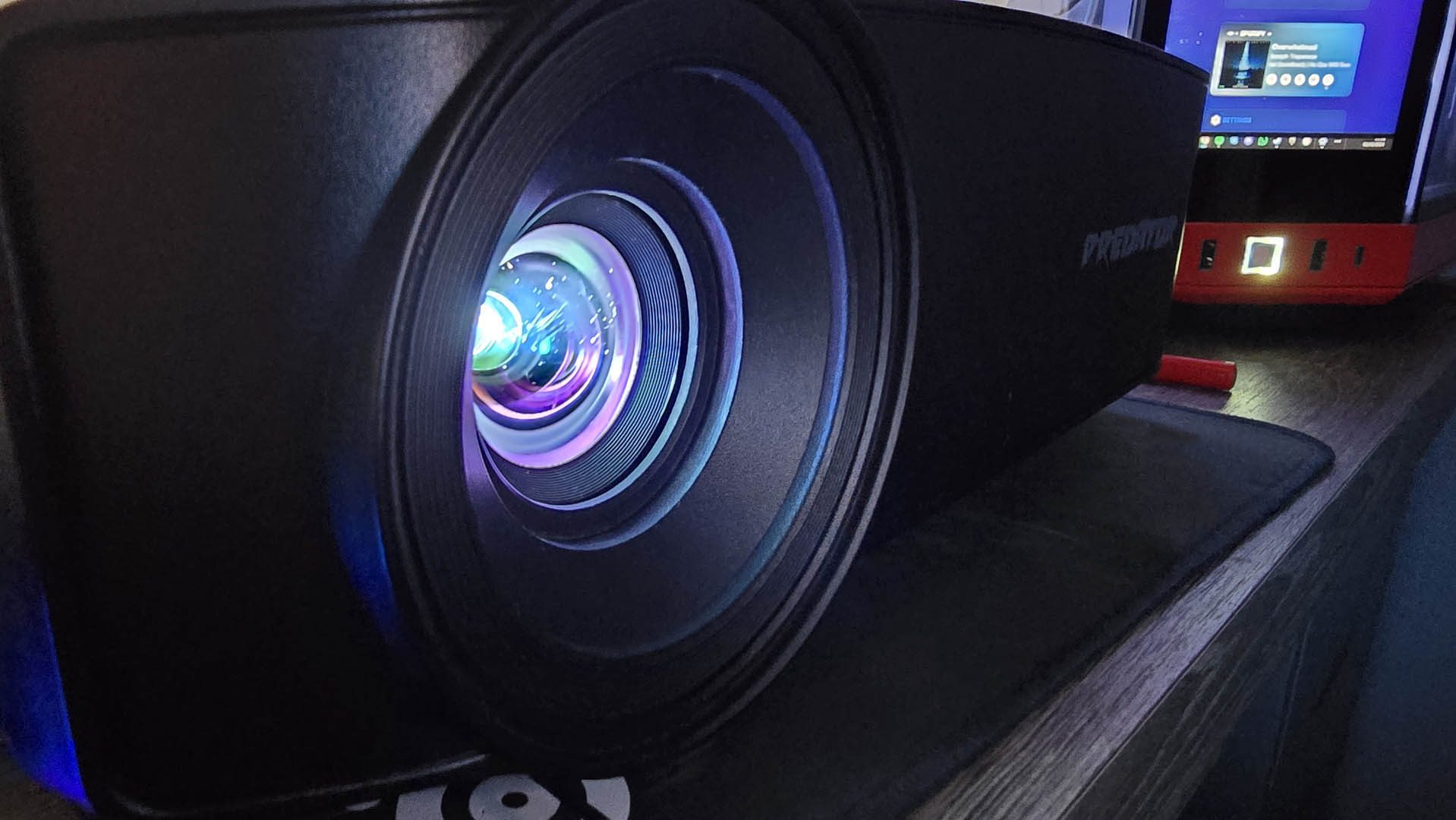
Should You Buy It?
- Yes: If you want a solid entry-level gaming projector
- Yes: If you have the space to support a bigger display size
- Yes: If you’re a casual gamer, and don’t mind colors not being super vibrant
- No: If you’re looking for the best value per $ display
- No: If you want the best color accuracy
As far as gaming projectors go Acer’s Predator GD711 is an interesting proposition. On the one hand, its vast feature set and fairly low-level price point for a 4K projector make it a solid pick for those looking to get into the scene or are after a big party piece display to game with their friends. On the other, its color accuracy leaves a lot to be desired.
Alternatives
If you’re after the best gaming projector you can buy, something like BenQ’s X3100i is a fantastic pick. Although somewhat chunky by comparison, and more suited to a table or a shelf attachment, there’s no denying just how incredible its color accuracy is, particularly as it matches the GD711 in every gaming element.
The problem, however, lies not in the world of projectors, but more so in the form of dedicated TVs and monitors as well. The former, you can typically find at similar prices with OLED panels and higher refresh rates at 50 inches and above and comes with better speakers, and the latter includes even richer gaming specs (such as 0.01 ms g2g, G-Sync premium), faster refresh rates, and just as many bells and whistles, for even less investment.
If 4K gaming at high refresh rates is what you’re after, AOC’s AGON Pro AG324UX ticks all the boxes, at less than half the price of the GD711, or if you’re after something with a bit more diagonal heft, then Gigabyte’s 54.6-inch S55U 4K 120 Hz VA display will fit the bill even better than that.
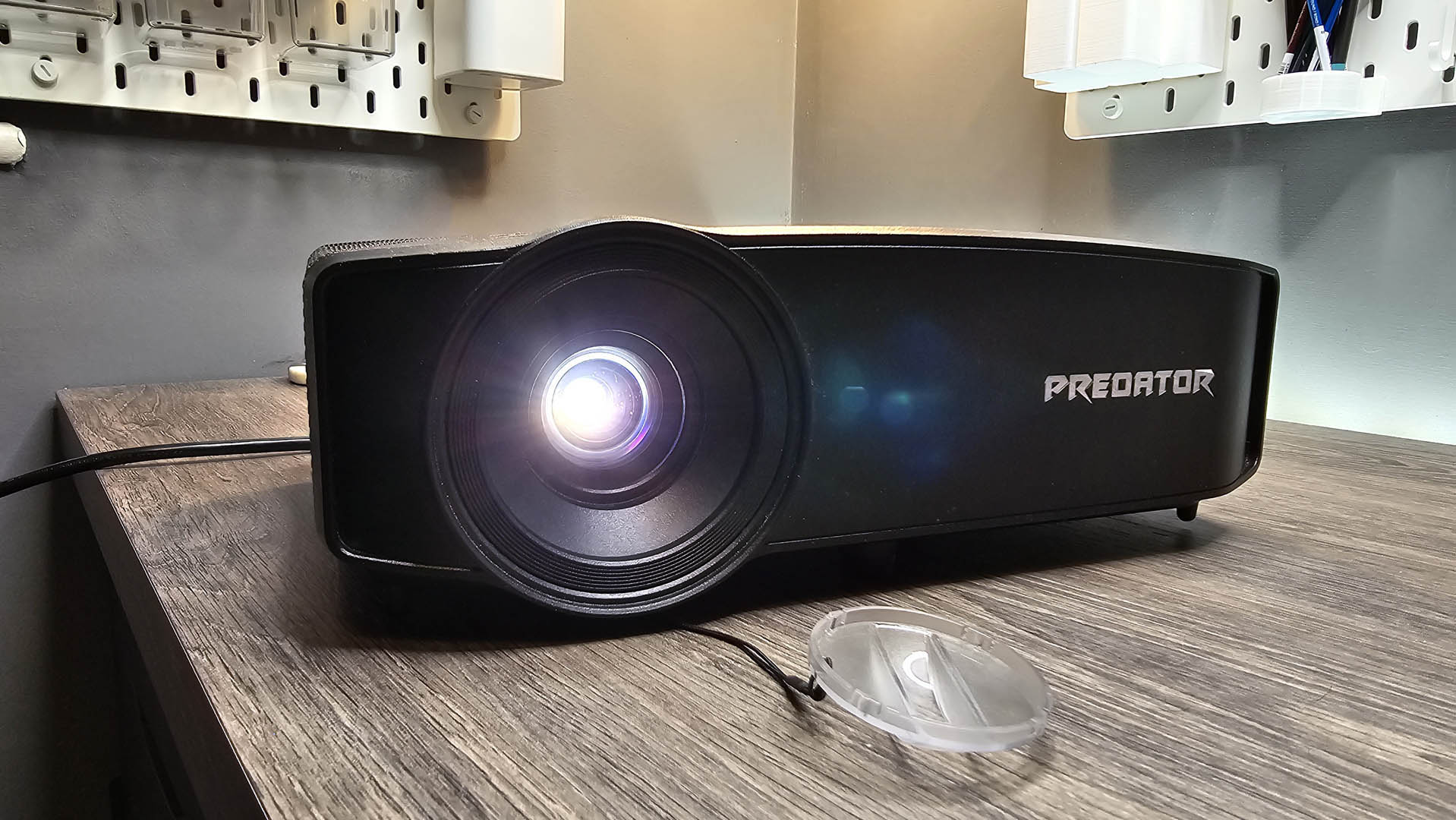
Verdict
Acer’s Predator GD711 Gaming Projector comes with some impressive software tech, and, at the price point provides a seriously tempting proposition compared to some of its competition. However, the lack of color accuracy hurts it long-term, particularly compared to some of the competition from both OLED TVs and monitors at around the same RRP. It’s a solid unit, but a niche projector for 4K gaming.
